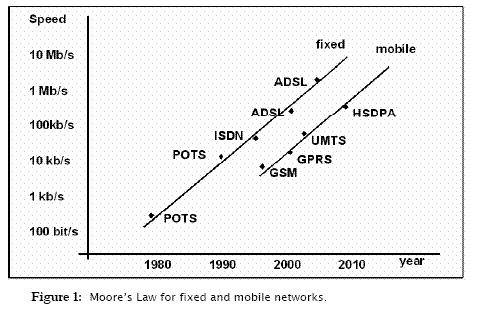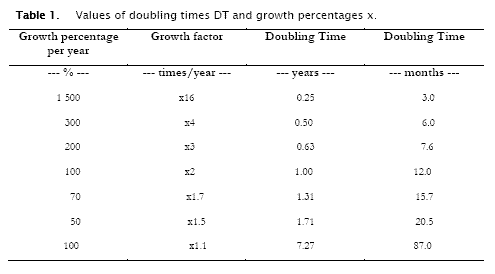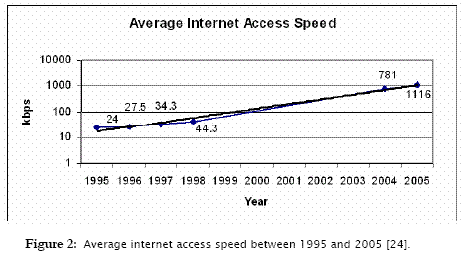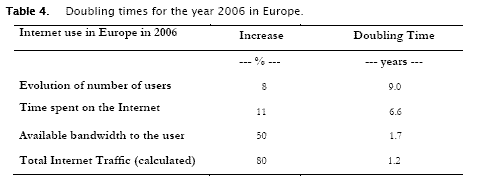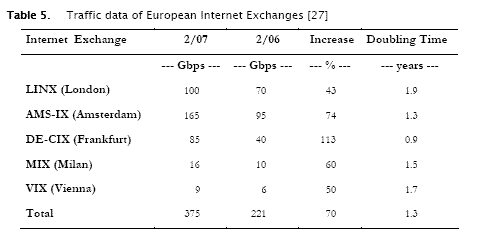Services on Demand
Journal
Article
Indicators
-
 Cited by SciELO
Cited by SciELO -
 Access statistics
Access statistics
Related links
-
 Similars in
SciELO
Similars in
SciELO
Share
Acta Nova
On-line version ISSN 1683-0789
RevActaNova. vol.3 no.4 Cochabamba 2007
A Model for Internet Traffic Growth
Johannes W. Meijer
Departamento de Ciencias Exactas e Ingeniería, Universidad Católica Boliviana
Av. General Galindo s/n, Cochabamba, Bolivia
e-mail: meijgia@hotmail.com
Abstract
A simple model that let us predict the doubling time of Internet traffic is presented. The growth of this traffic depends on three factors, that is the doubling time of the number of users that are online, the doubling time of the time that they spend online and the doubling time of the bandwidth provided to the end user by telecommunication networks. The first and the second depend primarily on marketing strategies while the last one depends on Moores Law. In 2006 in Europe these three doubling times led to an expected doubling time for the traffic on the Internet of roughly 1.2 years. The real value of the doubling time of the traffic of a group of European Internet Exchanges agrees well with the expected value.
1 Introduction
"Theres plenty of room at the bottom!" was the intriguing title of the speech that Richard Feynman gave at the end of 1959 at the annual meeting of the American Physical Society at Caltech. It was an invitation to enter a new field of physics. What Feynman talked about was the problem of manipulating and controlling things on a small scale. There was nothing in the physical laws that he could see that said the computer elements could not be made enormously smaller than they were. In fact, there might be certain advantages [1]. Gordon Moore of Intel pointed out that by making things smaller, everything gets better simultaneously. There is little need for tradeoffs. The speed of products goes up, the power consumption goes down, system reliability, as we put more of the system on a chip, improves by leaps and bounds, but especially the cost of doing things electronically drops as a result of the technology [2] [3]. In 1959 some people were already heading in the direction proposed by Feynman. Earlier that year Jack Kilby of Texas Instruments patented the first integrated circuit while Robert Noyce and his colleagues at Fairchild Semiconductor succeeded in turning the integrated circuit from a laboratory prototype into a product that could be produced in ever increasing numbers. A lot however still had to done. An important milestone was reached in 1971, when Intel succeeded in putting the first computer on a chip. At Intel they called it a microprocessor. Very soon it would become the soul of a new machine called the personal computer.
2 Moores Law revisited
It is not always chaos that rules the market although this seems frequently to be the case in the financial markets; this is certainly not the case in the ICT markets. In the ICT markets Moores Law rules supreme. Since Gordon Moore formulated his law in 1965 it has served as the ultimate ICT signpost and few people are willing to bet against it because everybody who did lost.
A generalization of Moores Law states that all performance indicators applicable to the field of information and communication technology improve by a factor of two every 1 to 2.5 years [4]. The storage capacity of hard disk drives doubles roughly every year and the processing power of microprocessors doubles every two years [5]. Furthermore in December 2002 I reported that the bandwidth provided by wireless and wireline networks doubled roughly every 2.5 years [6]. This doubling time has gone down to 1.7 years in recent years as I show in this article (Fig 1).
There is a quick and simple way to determine the doubling time of a parameter. Determine the number of years that it takes for this parameter to grow by a factor of 1000. Divide this number of years by 10 and you find the value of the doubling time. This trick is justified due to the fact that 1000 ≈ 210. The exact relation between the doubling time DT and the growth percentage x is given by DT = ln (2) / ln (1+ x/100), see table 1 for some values.
The value of a doubling time is normally a long term average that varies over time [2]. Lets assume that the growth of a specific market, e.g. the number of people online, follows an S-curve. Under these circumstances the growth percentage x(t) is a function of time that starts to decrease when half the population is online. When market saturation sets in, that is almost everybody is online, the growth percentage approaches zero and the doubling time infinite.
3 Software, Science and Games.
The software industry in general has always been the foremost driving force behind the semiconductor industry. The variation on Parkinson's Law "Software expands to fill the available memory!" speaks for itself [3]. Another relentless driver has been the scientific community which is constantly on the lookout for chips that can provide more processing power. The computer games industry is an equally powerful force that uses processing power and memory indiscriminately. Chess computers provide a nice example. In 1988 Igor Ivanov was the first international master who lost a serious game from a computer. Some commentators thought that Ivanov must have been drunk. They overlooked that Moores Law was at work here. Human chess players simply cant keep up with computers that double their processing power every two years. In 1997 world champion Garry Kasparov learned it the hard way when he lost a short match from IBMs Deep Blue and in 2006 world champion Vladimir Kramnik met the same fate against Deep Fritz [7].
4 Bandwidth the fifth basic need.
Since the arrival of the Internet in 1991 and the Netscape browser in 1995 bandwidth has become, just like food, drink, sleep and sex, a primary need. In 1998 I reported that the average bandwidth provided by (POTS) modems and ISDN terminal equipment followed the rhythm of Moores Law with a doubling time of roughly 2.4 years [4]. Nielsen [8] and Eldering et. al. [9] reported doubling times of 1.6 and 1.9 years. These doubling times are lower due to their rather late introduction data for the earlier modems. Since the arrival of high speed ADSL terminals in 2001 this doubling time went down to 1.7 years, see figure 2. In 2005, when the average connection speed to the internet was 1116 kbps, top speeds of 12 Mbps downlink and 1024 kbps uplink were available to customers who were willing to pay for it. At that time just about 3% of the access connections made use of this top speed.
An intriguing fact is that from 1979 until 1996 the telephone network was, due to Shannons Law, transparent for all modem speeds. During that period bandwidth was essentially free. The development of modems was of course ruled by Moores Law. The question that comes to my mind is why the IT industry didnt take advantage of this free bandwidth goldmine. The answer to this question is of course quite simple. It would have required Moore to quicken the pace of his own law. Apparently the rate of progress in the ICT market is limited by his law.
Mobile data networks became available in earnest with GPRS networks in 2001.
Typical speeds of 40 kbps downlink and 20 kbps uplink became available. In 2004, when UMTS networks became operational, the initial speed was 64 kbps. In 2006 typical UMTS data rates of 384 kbps on R99 handsets became widely available. These three data points represent a doubling time of 1.6 years, which is similar to the one for fixed networks.
We observe once again that Moores Law rules supreme in both fixed and mobile networks. This was also shown by Phil Edholm of Nortel and Hossein Eslambolchi of AT&T [10].
In 2002 I expected that broadband communication of 384 kbps on wireless networks would become available at the earliest in 2006 but more likely in 2008 [6; 11]. Mobility has proven to be a much desired feature for many applications by a whole lot of people. This has speeded up developments in mobile networks and the 384 kbps target was already reached in 2006.
Nowadays HSDPA networks are being deployed in many countries. Typical downlink data rates up to 1 Mbps can be reached with these networks. The theoretical maximum data rate is 14.4 Mbps. I expect that it will take some time before these networks become the preferred way to connect to the internet..
A bandwidth corollary to Moores Law
The analysis given above leads to the following corollary to Moores Law: The bandwidth provided for by communications networks doubles roughly every 1.7 years. This corollary tells us that in 1.7 years we will have about twice todays bandwidth at our disposal at a price we are willing to pay.
5 The end of Moores Law
According to Ed Schaller it is occasionally overlooked that, in stark contrast to what would seem to be implied by the dependable doubling of transistor densities, the route that led to today's chips was anything but smooth [3]. The cost of building a next generation chip factory or fab always was a big roadblock. This cost doubles roughly every four years, a phenomenon known as Rocks Law [2]. So in the end it might be economics that will limit the number of components on a chip [12]. According to Gordon Moore in order to cram more components on a chip we depend on two size factors: bigger dice and finer dimensions [2]. Max Schultz argues that the end of the road for silicon will be reached by 2012 when the narrowest feature of silicon devices – the gate oxide – would reach its fundamental physical limit [13]. This implies that as soon as all the room at the bottom is used up Moores Law will be dead. So money and physics are the limiting factors to Moores Law [14]. The question that has to be answered in this decade is how to proceed beyond Moores Law.
6 A brief History of Internet Traffic Doubling Times
From 1997 till 2000 representatives of WorldCom and its subsidiary UUNet told their audiences time and again that the Internet traffic was doubling every three to four months. These doubling times imply growth percentages between 700 and 1500 percent. Demand would far outstrip supply for the foreseeable future. The catch phrase they used to get their message through was If youre not scared, you dont get it! [15]. George Gilder shared the same unshakable belief in these doubling times which according to him would ultimately lead to an era of free bandwidth [16]. Another proponent of this kind of doubling time was Larry Roberts, one of the founding fathers of the Internet, who stated in January 2000 that the doubling time of Internet traffic between 1997-2008 would be 6 months, i.e. a growth percentage of 300 percent [17]. In 2002 they all must have been scared when WorldCom had to file for Chapter 11 bankruptcy protection. It wasnt the only mayor Telco that went down after the Internet bubble burst. Among the casualties were Global Crossing and KPNQwest.
At the other end of the spectrum Coffman and Odlyzko discovered in 1998 that Internet traffic was doubling only roughly each year. More precisely it was growing at rates between 70% and 150% per year. Such growth rates applied not only to the entire Internet, but to a large range of individual institutions as well. Even when there were no obvious bottlenecks traffic tended not to grow faster [18]. At about the same time Peter Sevcik reported similar findings in Business Communications Review [19]. Roberts restated his earlier prediction in March 2002 when he said that Net traffic growth over the next few years could be between 100% and 200% per year. According to Coffman and Odlyzko this exponential growth appeared to reflect complicated interactions of technology, economics, and sociology, similar to, but more delicate than those that have produced Moores Law in semiconductors [20] [21] [22]. A simple model that explains the growth rates found by the Coffman and Odlyzko will be presented in the paragraphs that follow.
7 Internet traffic, a combination of Moores law and smart marketing
Internet traffic grows three ways – more users, longer connect times and more available bandwidth for the end user. The bandwidth factor has already been considered in the preceding paragraphs and what follows is a description of the effects of the other two factors.
The art of estimating how many people are online throughout the world is an inexact one at best. Surveys abound, using all sorts of measurement parameters. Most numbers are "educated guesses" at best as to how many people are online. Obviously the methodologies used by different marketing research institutes differ. For my analysis I am only interested in the growth rates per year. Absolute numbers dont matter much. A sound methodology is sufficient. This becomes strikingly clear if we compare the numbers in table 2 from internetworldstats.com with those of comScore Networks of March 2007. The latter announced that between January 2006 and January 2007 the number of Internet users worldwide age 15+ increased with 10%; up from 677 to 745 million. Their user numbers are much lower than those given in table 2. The reported percentages are however similar.
The number of users on different continents grow at different rates. Differences in local market circumstances clearly play an important role.
Another factor that contributes to the growth of Internet traffic is the increase in the time that people spend online. The time online goes up now that ever more people are moving to broadband access for which they pay a flat fee. In March 2007 comScore Networks reported that for example in Canada in January 2007 the average broadband user was on-line for 41.3 hours versus 14.2 hours for narrowband users. A remarkable difference.
In November 2006 the European Interactive Advertising Association (EIAA) published the data presented in table 3. We observe that the growth rate for the time spent on the internet in 2006 was 11% which leads to a doubling time of 6.6 years.
7.1 A model for the growth of Internet traffic
The doubling times for the number of people online, the time they spent on the web and the available bandwidth to the user in the year 2006 can be found in table 4. The increase of the total Internet traffic depends on these three factors. The combination of these three factors, under the assumption of exponential growth with doubling times DT, leads to IT(year) = IT(year=0).2year/DTnumber of users.2year/DTtime online.2year/DTbandwidth where IT stands for Internet Traffic. From this formula it follows that 1/DTinternet traffic = 1/DTnumber of users + 1/DTtime online + 1/DTbandwidth In Table 4 we apply this formula to the situation in Europe in 2006.
With the three values given in table 4 it is easy to calculate that DTinternet traffic was 1.2 years for Europe in 2006. In the next paragraph I compare this calculated value with the actual value.
7.2 Internet traffic data from European Internet Exchanges
In this paragraph I analyze Internet traffic data from several European Internet Exchanges. I collected the data in table 5 from their websites. Changes in the amount of traffic that passes through an Internet Exchange are normally due to market changes but unexpected large swings are most probably caused by rerouting of traffic. To limit the influence of this swing effect I have looked at the total traffic instead of at the traffic of individual exchanges.
I found for the total traffic of major European Internet Exchanges a doubling time of roughly 1.3 years in the period between February 2006 and February 2007. We can compare the observed value of DTinternet traffic = 1.3 years with the calculated value of DTinternet traffic= 1.2 years. These values coincide quite well. The DT of 1.3 years lies between the upper and lower bounds given by Coffman and Odlyzko of 0.75 (x = 150%) and 1.3 years (x = 70%).
At the FITCE congress in Berlin in 2003 I presented Internet traffic data for the year 2001. The three basic doubling times were all 2.5 years which led to a calculated DTinternet traffic for 2001 of 0.83 years. The measured DTinternet traffic was 0.95 years [23]. If we compare the 2006 and 2001 data we observe that both the growth of the number of users and the time that they spent online have slowed but that developments in technology have picked up speed.
Lets have a look into the future. As a starting point we take again the year 2006 for Europe. In 2006 the doubling time of the Internet traffic was roughly 1.2 years. At some point in time everybody will be online and DTnumber of users = ∞ years. When the average time that users spend online doesnt increase anymore we have DTtime online is infinite. Beyond that point in time only DTbandwidth, that is to say as long as Moores Law holds, will contribute to the doubling time of the Internet traffic which will eventually slow down to 1.7 years.
8 Conclusions
How fast does the traffic on the Internet double? Does it double every three months, six months, every year or every two years? The wrong answer to this question led to the downfall of several major players in the telecommunications market. So it is clear that a model that enables us to predict the doubling time for the traffic on the Internet can help us from losing fortunes again. In this article a simple model that enables us to predict the growth of this traffic was presented. It was shown that the growth of the traffic on the Internet depends on three factors: the doubling time of the bandwidth provided to the end user by telecommunication networks, the doubling time of the number of users that are online and the doubling time of the time that they spend online. The first one depends on Moores Law and the second and third depend on marketing strategies. In the future the doubling time of Internet traffic will slow down from 1.2 (x = 80 %) to 1.7 years (x = 50 %). These growth rates are all very high and must be considered disruptive from an engineering point of view. To be able to accommodate all this extra traffic special precautions have to be taken.
References
[1] Regis, Ed. 1997. Nano ! In: http://www.zyvex.com/nanotech/feynman.html. [ Links ]
[2] Moore, G. 1965. Cramming more components onto integrated circuits. Electronics, Vol. 38, Nº 8, pp. 114-117, April 19. In: http://www.ieee.org/portal/site/sscs/. Look for Moores Law in the Technology section or the SSCS newsletter of September 2006. [ Links ]
[3] Schaller, R. R. 1997. Moores Law: past, present and future. IEEE Spectrum. June. [ Links ]
[4] Meijer, J. W.; Geraards, M. 1998. Convergence and Divergence in Business Communications. British Telecommunications Engineering. Vol. 17, Part 2 (182-186), See also the Proceedings of the 37th FITCE congress, London. August. 1998. In: www.fitce.org. [ Links ]
[5] Hennessy, J.L.; Patterson, D.A. 2002. Computer Architecture, a quantitative approach. 3rd edition. May. pp. 15, 456, 685, 686. Data on hard disk drives can be found at: www.redhill.net.au. [ Links ]
[6] Meijer, J.W. 2002. UMTS, Moores Law and Lickliders Trap, FITCE Forum, Dec. In: http://www.fitce.at/newsletter/dokumente/forum7.pdf. [ Links ]
[7] Moravec, H. 1998. When will computer hardware match the human brain? Journal of Evolution andTechnology. Vol. 1. In: http://www.transhumanist.com/volume1/moravec.htm. [ Links ]
[8] Nielsen, J. 1998. Nielsens Law of Internet Bandwidth. In: www.useit.com/alertbox/ 980405.html. [ Links ]
[9] Eldering, C.; Silla, M. L.; Eisenach, J. A. 1999. Is there a Moores Law for Bandwidth? IEEE Communications Magazine. October. pp. 117-121. [ Links ]
[10] Cherry, S. 2004. Edholm's Law of bandwidth. IEEE Spectrum. July. p. 58. In: http://www.questnet.net.au/questnet2006/papers/Phil_Edholm_v1.pdf. [ Links ]
[11] Meijer, J.W. 2002. The iron laws that rule the ICT markets. Acta Nova. Vol. 2, N° 1. December. pp. 82-91. UCB, Cochabamba, Bolivia. In: www.ucbcba.edu.bo. [ Links ]
[12] Meieran, E.S. 1998. 21st Century Semiconductor Manufacturing Capabilities. Intel Technology Journal. pp. 1-8. Q4. In: www.intel.com. [ Links ]
[13] Schultz, M. 1999. The end of the road for silicon? Nature. Vol. 399. pp. 729-730 [ Links ]
[14] Moore, G. 2003. No exponential is forever. International Solid State Circuits Conference, February. ISSCC. IEEE International Volume. Issue. pp. 20-23, Vol. 1. In: http://sscs.org/History/MooresLaw.htm. [ Links ]
[15] Dreazen, Y.J. 2002. How widely optimistic data drove telecoms to build fiber glut. Wall Street Journal, September 26. In: www.cmg.org/downloads/Fiber_Glut_WSJ_ 020926.pdf. [ Links ]
[16] Gilder, G. 1998. Paradigm Party. Forbes ASAP, 24 August. In: www.forbes.com/asap/ 1998/0824/094.html. [ Links ]
[17] Roberts, L. 2000. Beyond Moore's Law: Internet growth trends. IEEE Computer. Vol. 33, N° 1. January. pp. 117-119. [ Links ]
[18] Coffman, K.G.; Odlyzko, A.M. 1998. The size and growth rate of the Internet. First Monday, October. In: www.dtc.umn.edu/~odlyzko/doc/networks.html. [ Links ]
[19] Sevcik, P. 1999. The Myth of Internet Growth. Business Communication Review. January. pp. 12-14. In: www.bcr.com. [ Links ]
[20] Odlyzko, A. 2000. Internet Growth: Myth and Reality, Use and Abuse. iMP: Information Impacts Magazine. November. In: www.dtc.umn.edu/~odlyzko/doc/ networks.html. [ Links ]
[21] Coffman, K.G.; Odlyzko, A.M. 2002. Internet growth: Is there a Moores Law for data traffic?. Handbook of Massive Data Sets. Abello, J.; Pardalos, P. M.; Resende, M. G. C. (Eds.) Kluwer. pp. 47-93. In: www.dtc.umn.edu/~odlyzko/doc/networks.html. [ Links ]
[22] Coffman, K.G.; Odlyzko, A.M. 2002. Growth of the Internet, Optical Fiber Telecommunications IV B: Systems and Impairments. Kaminow, I. P.; Li, T. (Eds.) Academic Press. pp. 17-56. In: www.dtc.umn.edu/~odlyzko/doc/networks.html. [ Links ]
[23] Meijer, J.W. 2003. Internet traffic growth. A combination of Moore's Law and smart marketing. Journal of the Communications Network. Vol. 2, N° 3. pp. 83-88. See also the Proceedings of the 42nd FITCE congress, Berlin September 2003. In: www.fitce.org. [ Links ]
[24] The GVU Center of the Georgia Institute of Technology. Heavy Reading Market Research. Central Bureau for Statistics The Netherlands. Planet Internet The Netherlands. [ Links ]
[25] In: www.internetworldstats.com. [ Links ]
[26] In: www.eiaa.net. [ Links ]
[27] In: www.euro-ix.net. [ Links ]













